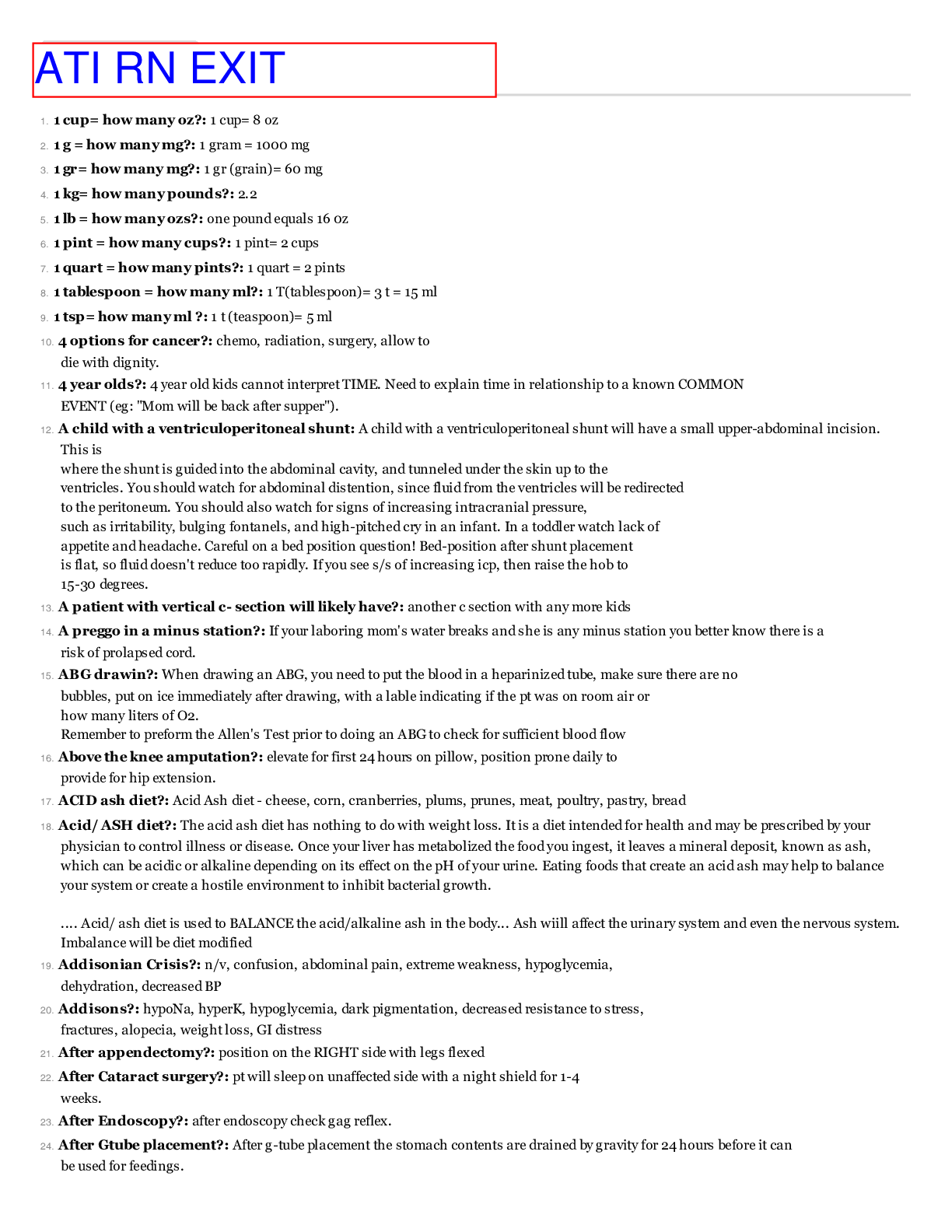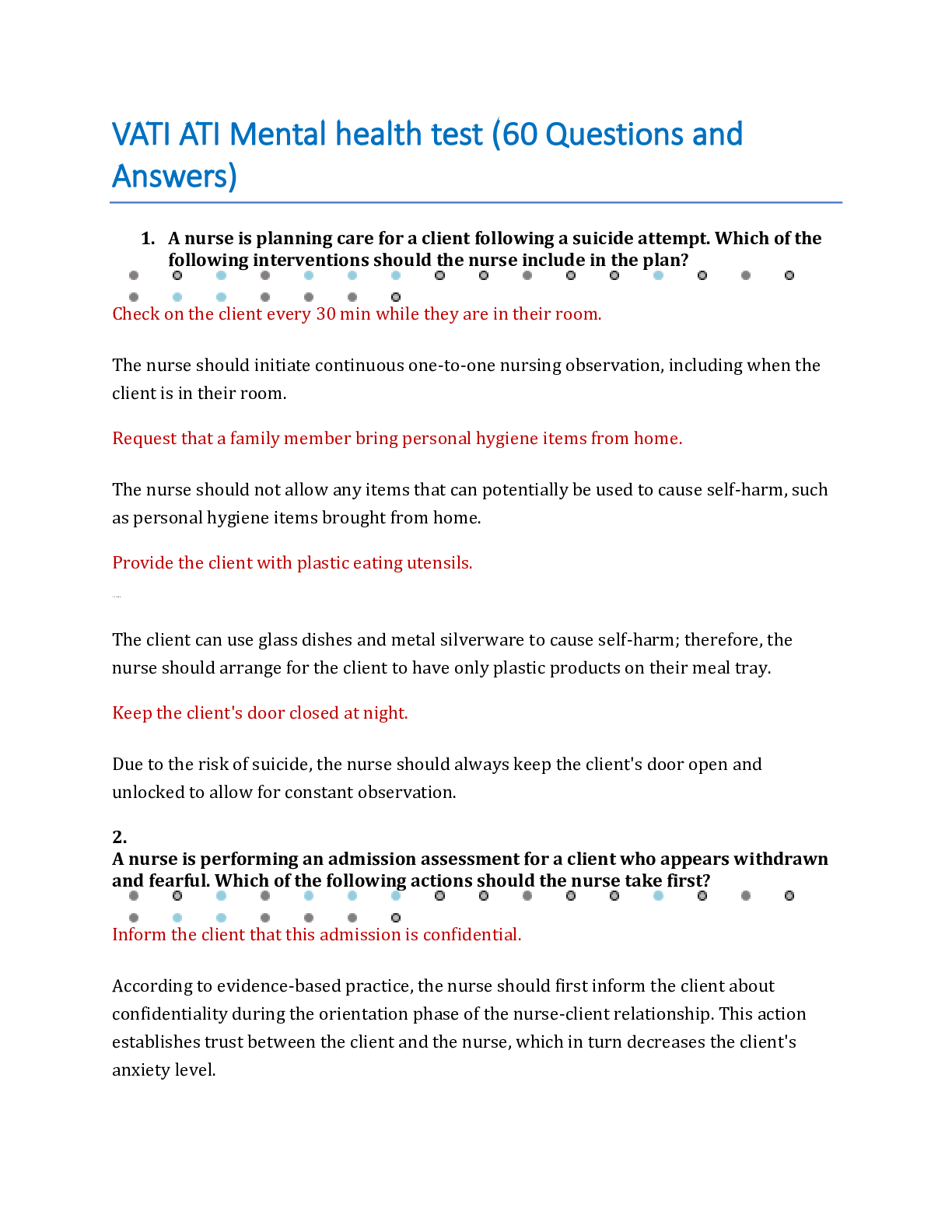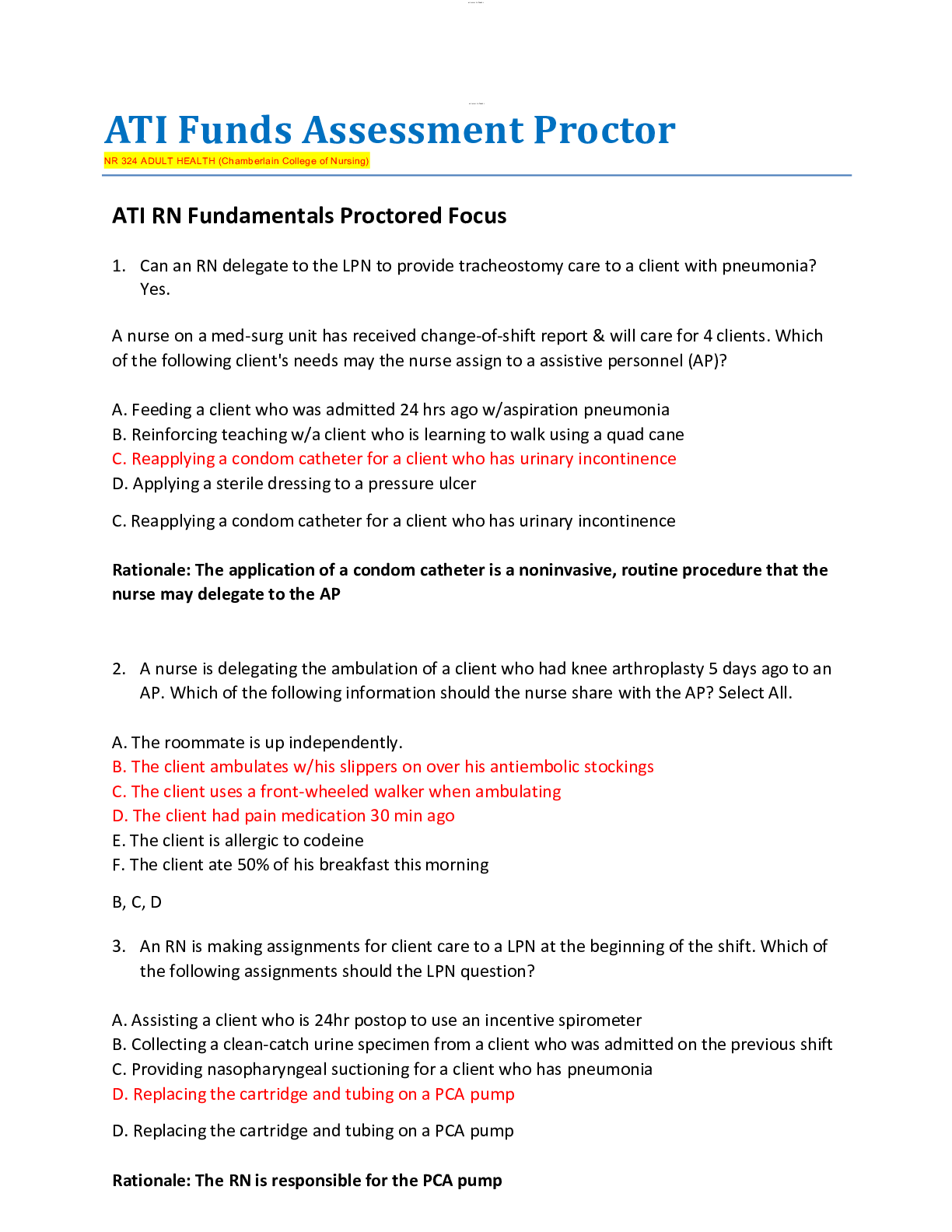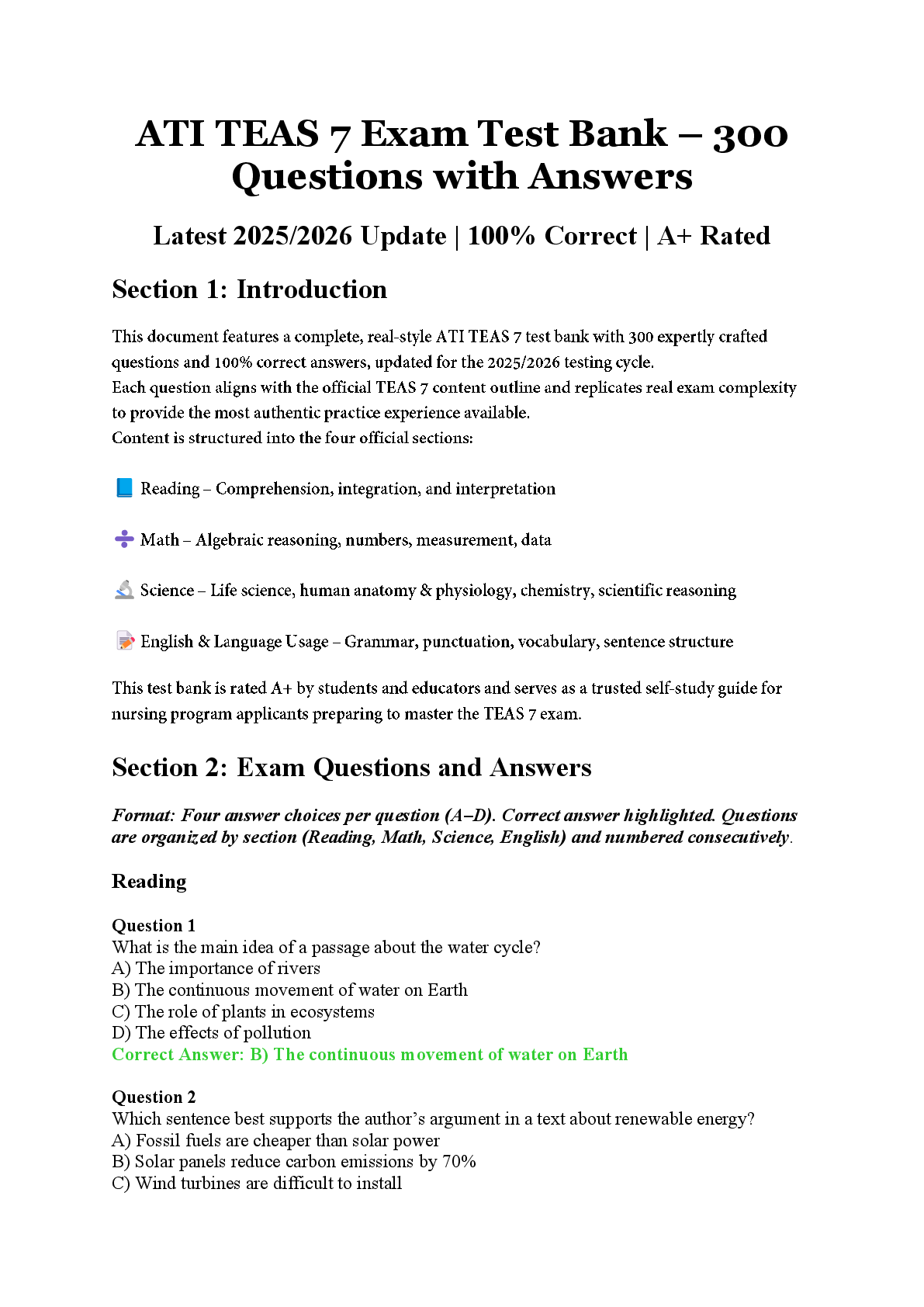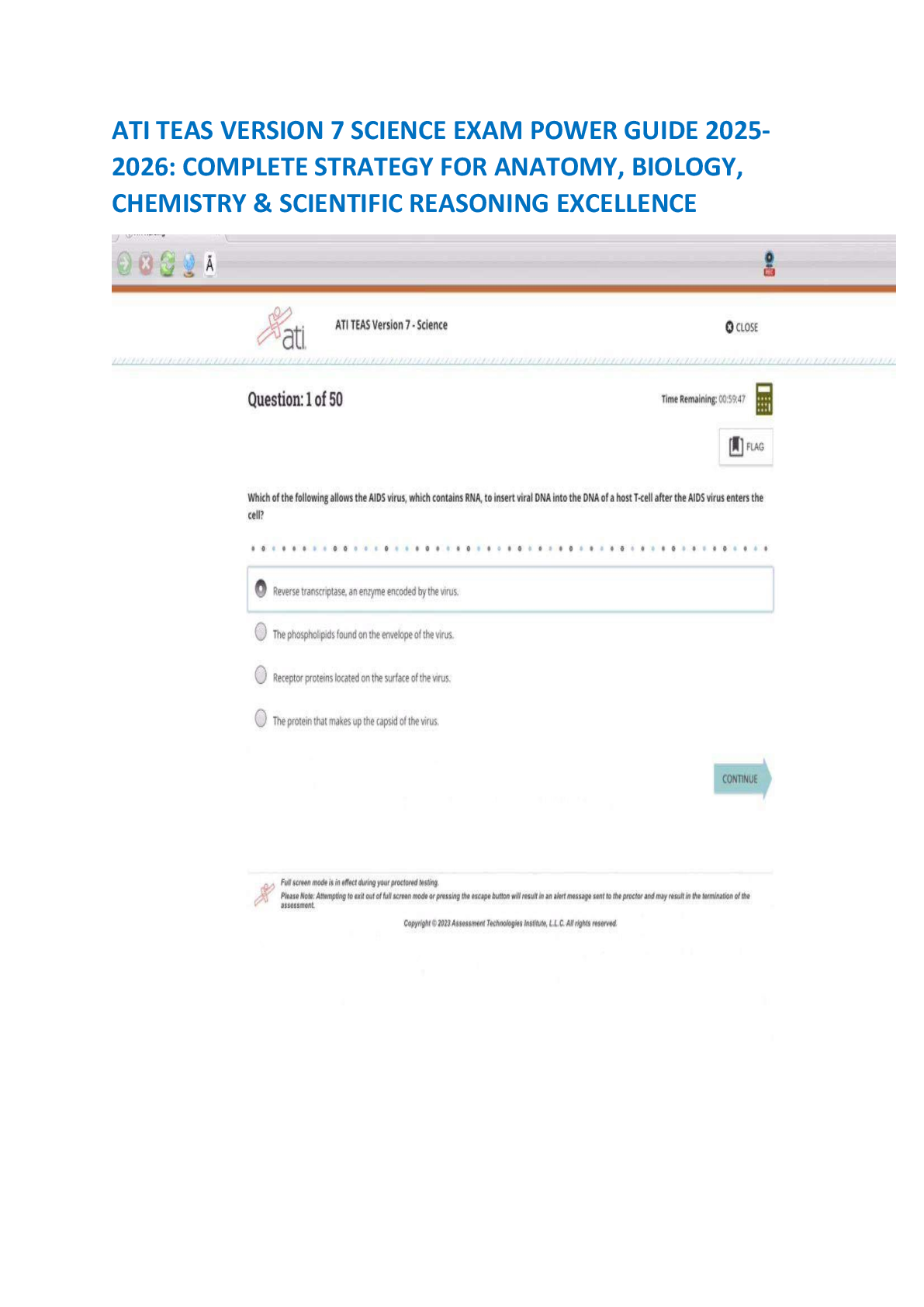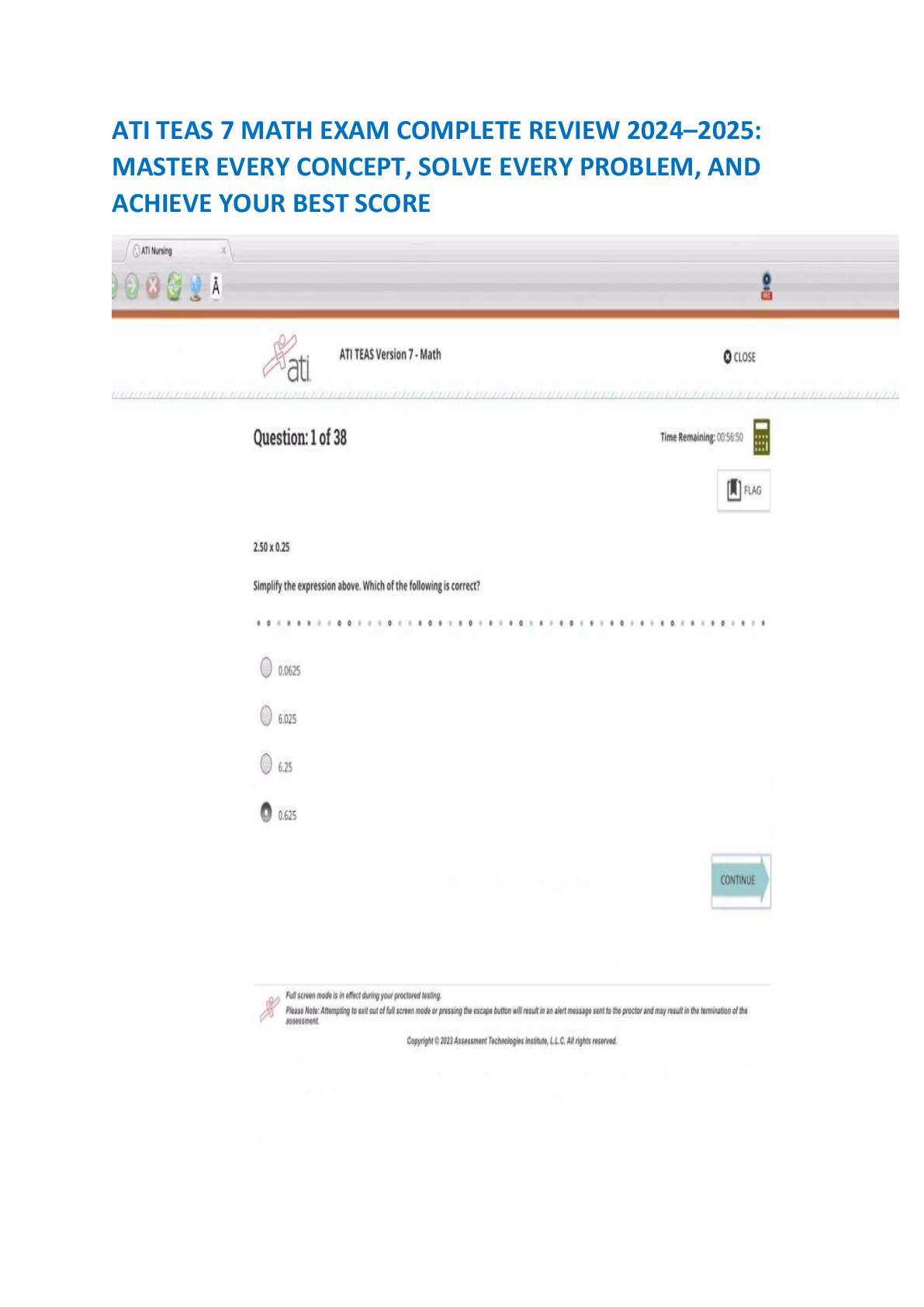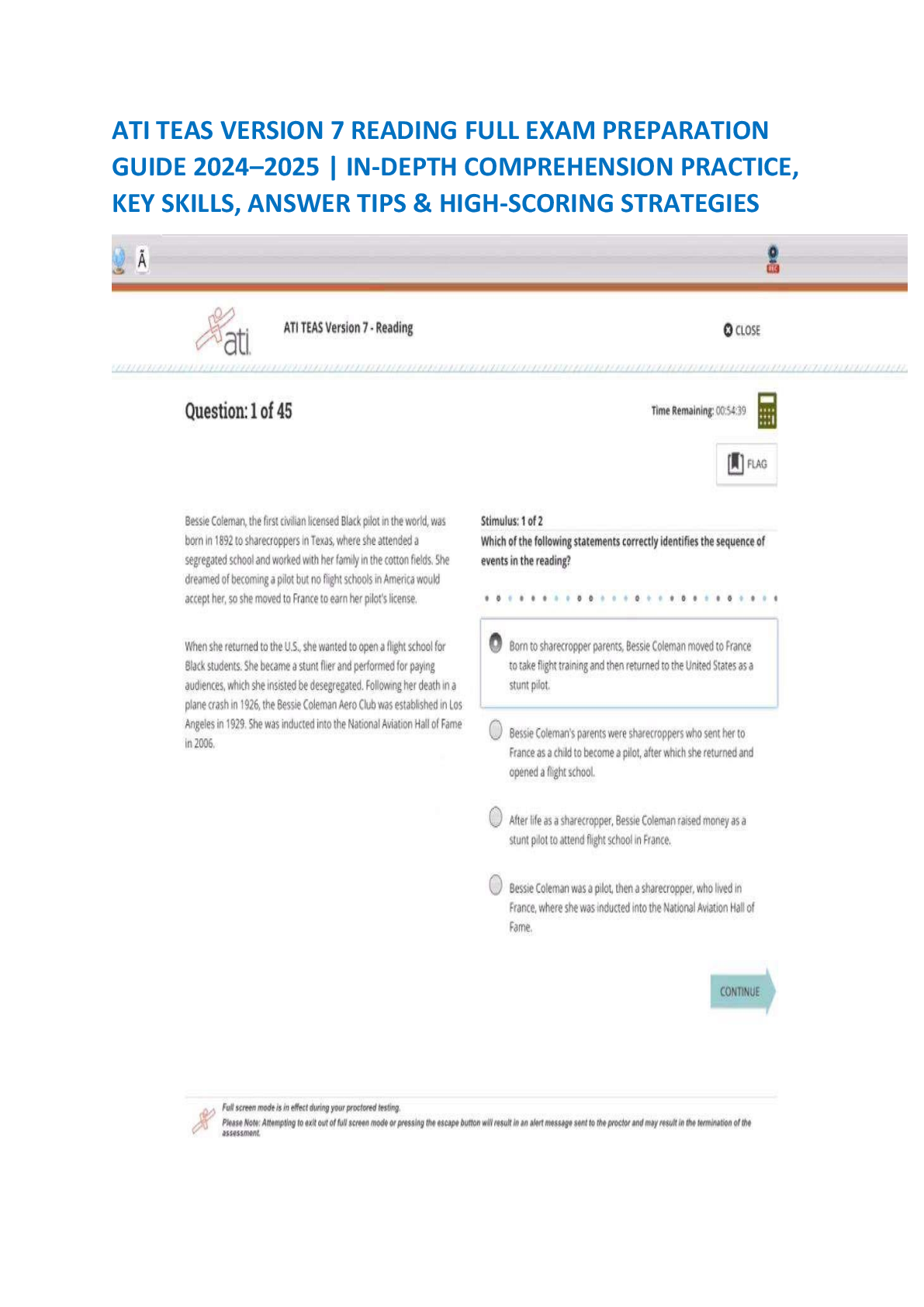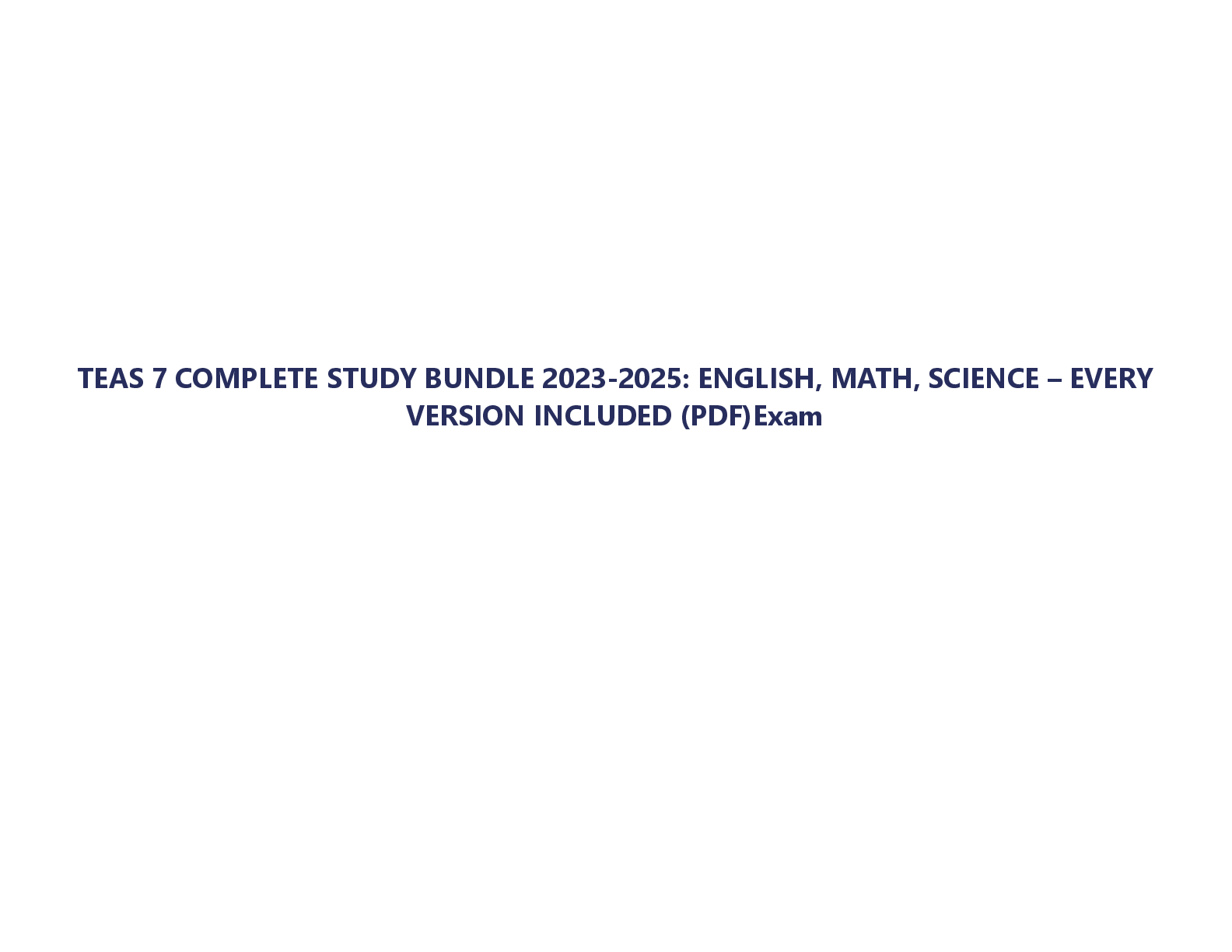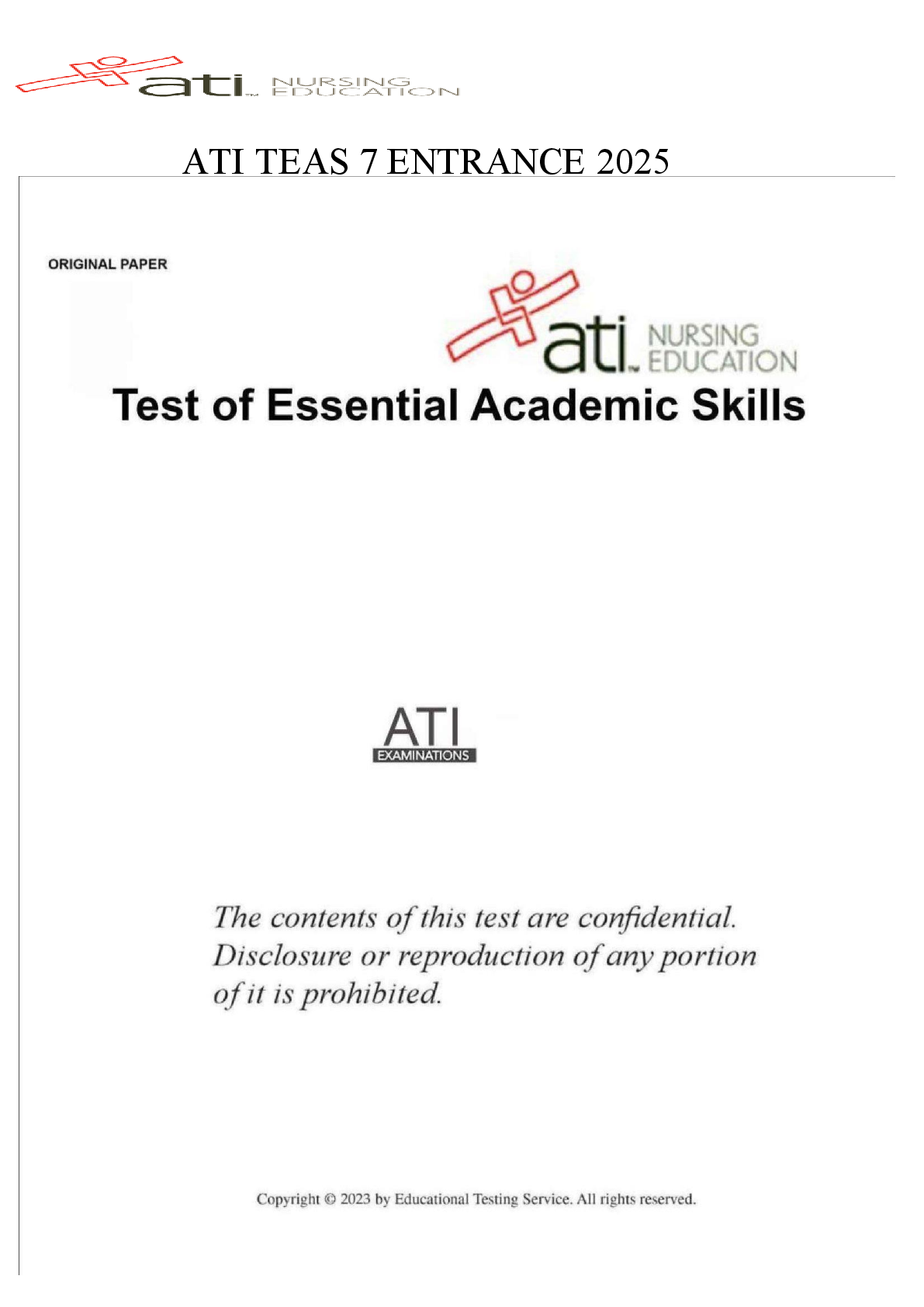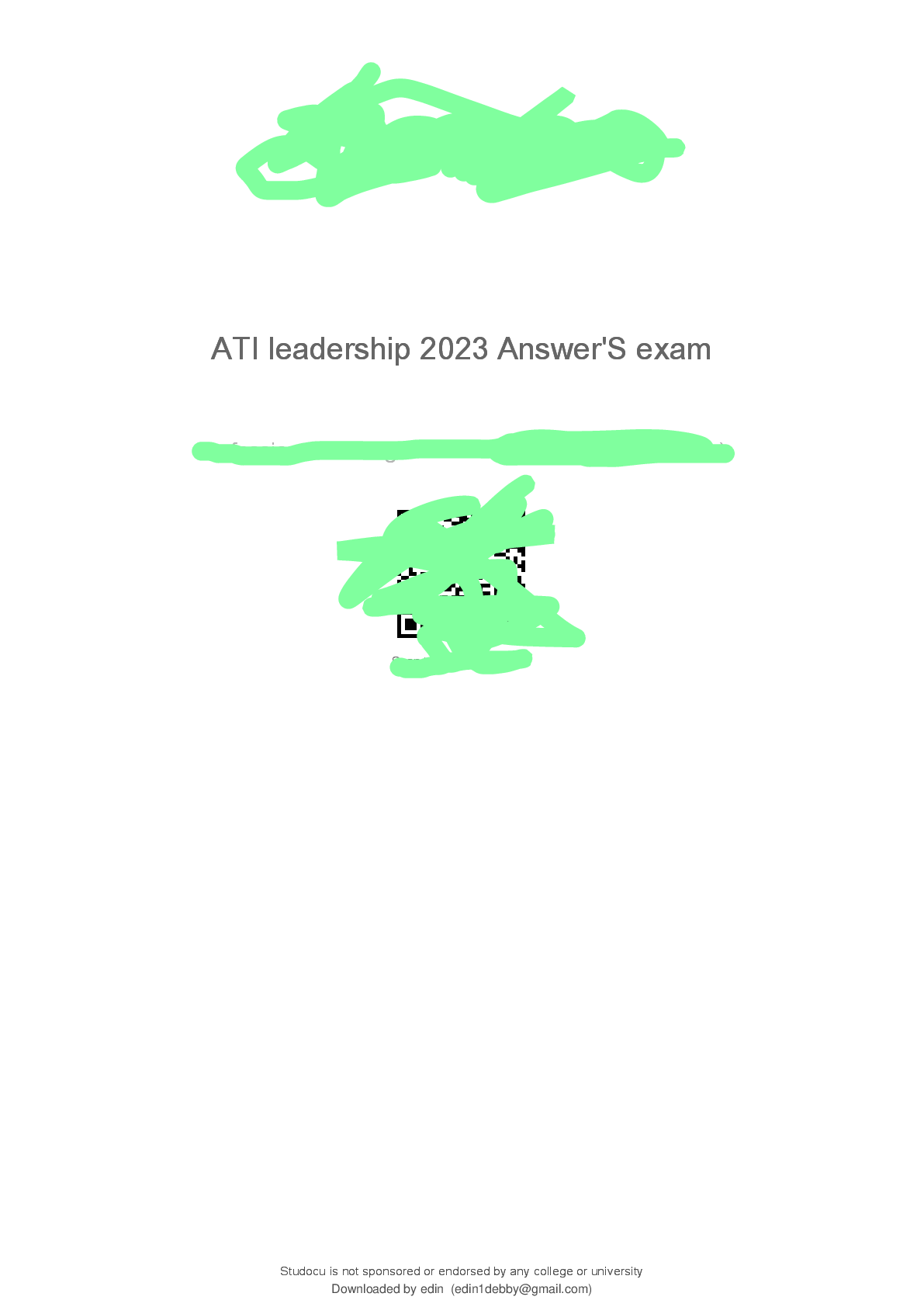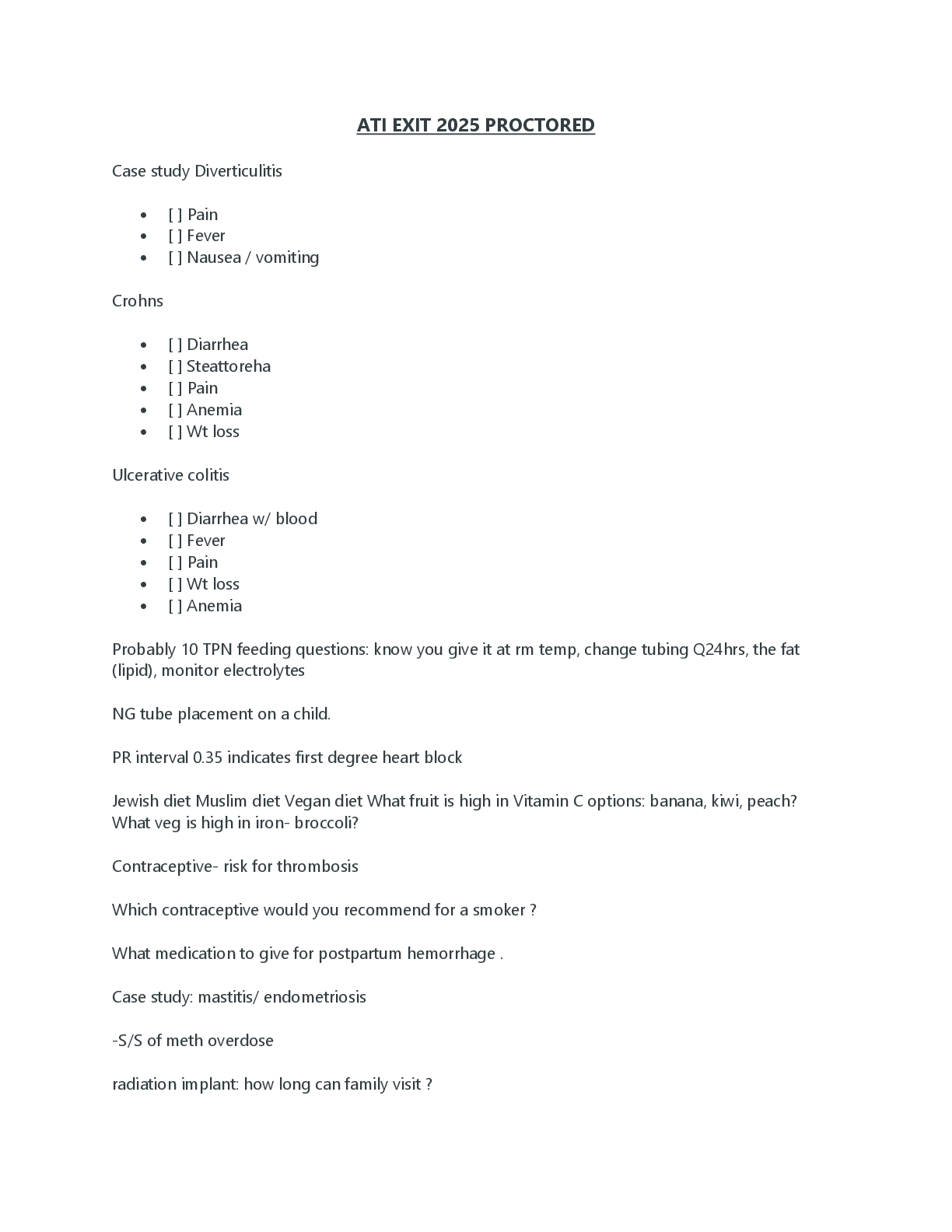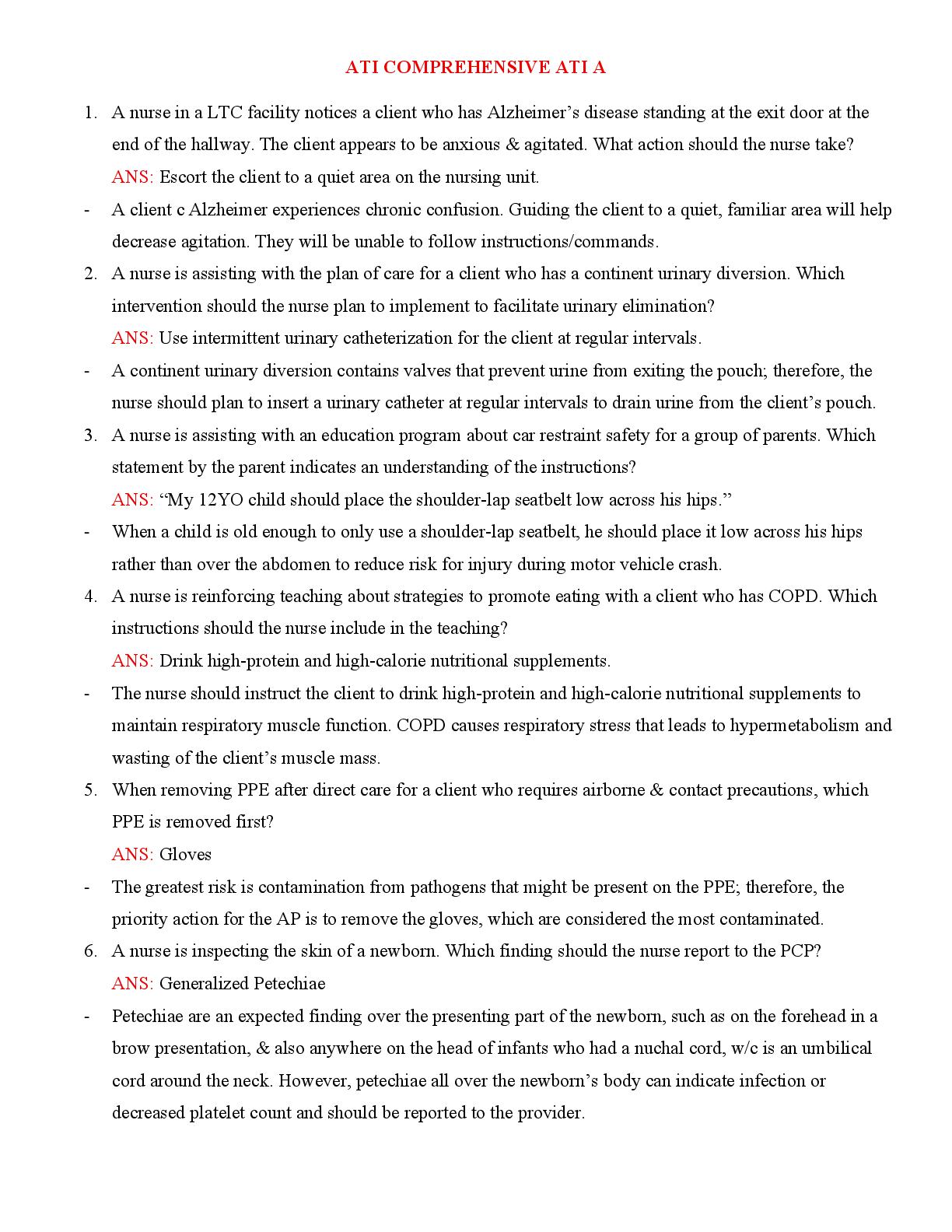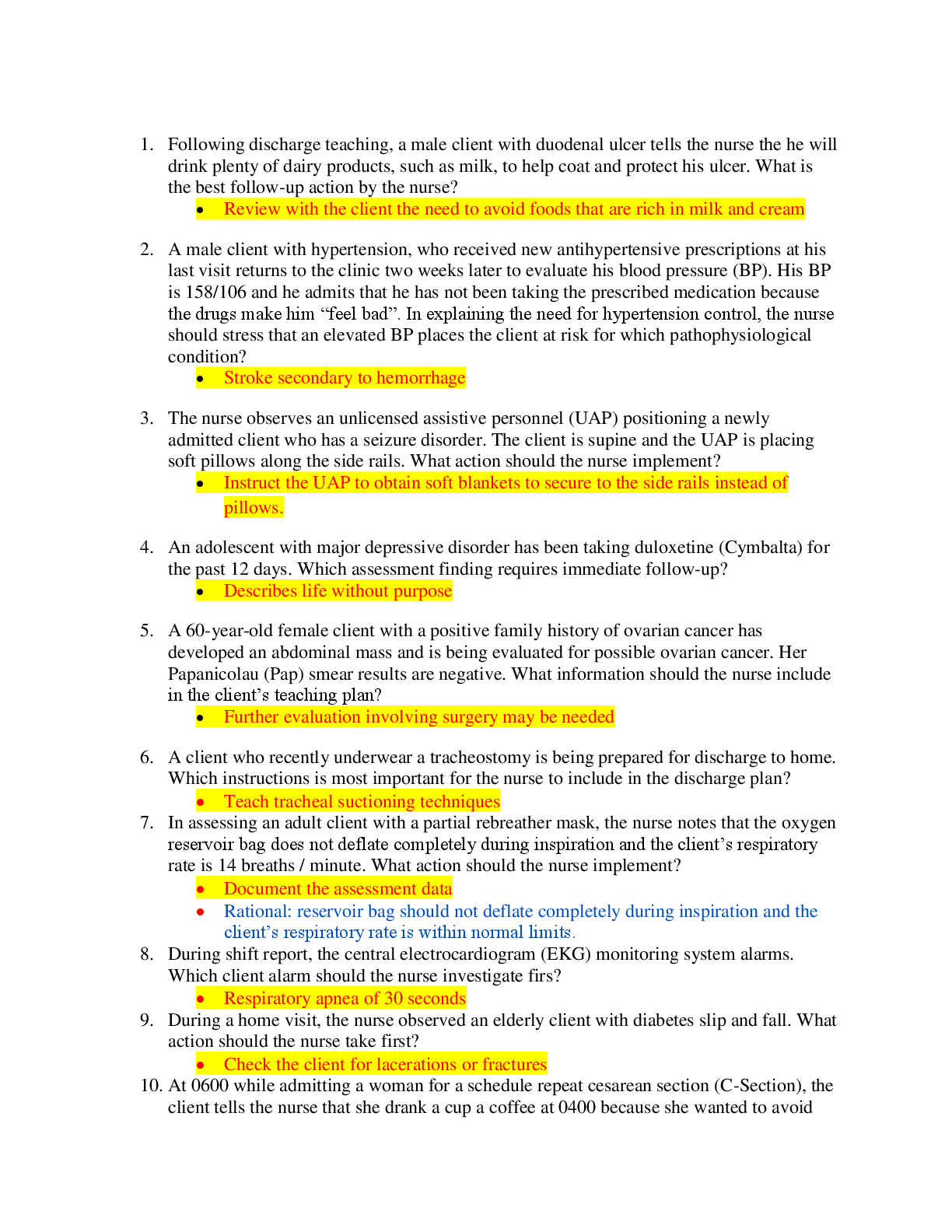ATI RN EXIT | Most Occuring Test Content for Quick study ahead of the Exam.
Document Content and Description Below
ATI RN EXIT | Most Occuring Test Content for Quick study ahead of the Exam. 1. 1 cup= how many oz?: 1 cup= 8 oz 2. 1 g = how many mg?: 1 gram = 1000 mg 3. 1 gr= how many mg?: 1 gr (grain)= 60 mg 4. ... 1 kg= how many pounds?: 2.2 5. 1 lb = how many ozs?: one pound equals 16 0z 6. 1 pint = how many cups?: 1 pint= 2 cups 7. 1 quart = how many pints?: 1 quart = 2 pints 8. 1 tablespoon = how many ml?: 1 T(tablespoon)= 3 t = 15 ml 9. 1 tsp= how many ml ?: 1 t (teaspoon)= 5 ml 10. 4 options for cancer?: chemo, radiation, surgery, allow to die with dignity. 11. 4 year olds?: 4 year old kids cannot interpret TIME. Need to explain time in relationship to a known COMMON EVENT (eg: "Mom will be back after supper"). 12. A child with a ventriculoperitoneal shunt: A child with a ventriculoperitoneal shunt will have a small upper-abdominal incision. This is where the shunt is guided into the abdominal cavity, and tunneled under the skin up to the ventricles. You should watch for abdominal distention, since fluid from the ventricles will be redirected to the peritoneum. You should also watch for signs of increasing intracranial pressure, such as irritability, bulging fontanels, and high-pitched cry in an infant. In a toddler watch lack of appetite and headache. Careful on a bed position question! Bed-position after shunt placement is flat, so fluid doesn't reduce too rapidly. If you see s/s of increasing icp, then raise the hob to 15-30 degrees. 13. A patient with vertical c- section will likely have?: another c section with any more kids 14. A preggo in a minus station?: If your laboring mom's water breaks and she is any minus station you better know there is a risk of prolapsed cord. 15. ABG drawin?: When drawing an ABG, you need to put the blood in a heparinized tube, make sure there are no bubbles, put on ice immediately after drawing, with a lable indicating if the pt was on room air or how many liters of O2. Remember to preform the Allen's Test prior to doing an ABG to check for sufficient blood flow 16. Above the knee amputation?: elevate for first 24 hours on pillow, position prone daily to provide for hip extension. 17. ACID ash diet?: Acid Ash diet - cheese, corn, cranberries, plums, prunes, meat, poultry, pastry, bread 18. Acid/ ASH diet?: The acid ash diet has nothing to do with weight loss. It is a diet intended for health and may be prescribed by your physician to control illness or disease. Once your liver has metabolized the food you ingest, it leaves a mineral deposit, known as ash, which can be acidic or alkaline depending on its effect on the pH of your urine. Eating foods that create an acid ash may help to balance your system or create a hostile environment to inhibit bacterial growth. .... Acid/ ash diet is used to BALANCE the acid/alkaline ash in the body... Ash wiill affect the urinary system and even the nervous system. Imbalance will be diet modified 19. Addisonian Crisis?: n/v, confusion, abdominal pain, extreme weakness, hypoglycemia, dehydration, decreased BP 20. Addisons?: hypoNa, hyperK, hypoglycemia, dark pigmentation, decreased resistance to stress, fractures, alopecia, weight loss, GI distress 21. After appendectomy?: position on the RIGHT side with legs flexed 22. After Cataract surgery?: pt will sleep on unaffected side with a night shield for 1-4 weeks. 23. After Endoscopy?: after endoscopy check gag reflex. 24. After Gtube placement?: After g-tube placement the stomach contents are drained by gravity for 24 hours before it can be used for feedings. ATI RN EXIT Study online at quizlet.com/_6x73d25. After Infratentorial Surgery?: (incision at nape of neck)--> position pt flat and lateral on either side. 26. After lumbar puncture?: e (and also oil-based Myelogram)--> pt lies in flat supine (to prevent headache and leaking of CSF) 27. After Myringotomy?: Position on the side of the AFFECTED EAR after surgery to allow drainage of secretions 28. After removal of the pituitary gland what should you watch for?: After removal of the pituitary gland you must watch for hypocortisolism and temporary diabetes insipidus. 29. After Supratentorial Surgery?: (incision behind hairline) --> elevate HOB 30-45 degrees 30. After Thyroidectomy?: low or semi-Fowler's, support head, neck and shoulders. 31. After Total Hip Replacement?: don't sleep on operated side, don't flex hip more than 45- 60 degrees, don't elevate HOB more than 45 degrees. Maintain hip abduction by separating thighs with pillows. 32. Age 4=5 year shots?: Age 4 to 5 yrs child needs DPT/MMR/OPV 33. Airborne Transmission?: My - Measles Chicken - Chicken Pox/Varicella Hez - Herpez Zoster/Shingles TB 34. Alkaline Ash diet?: Alk Ash diet- milk, veggies, rhubarb, salmon 35. Allen's test?: Allen's test - occlude both ulnar and radial artery until hand blanches then release ulnar. If the hand pinks up, ulnar artery is good and you can carry on with ABG/radial stick as planned. ABGS must be put on ice and whisked to the lab. 36. ALS?: Amyotrophic lateral sclerosis ( ALS ) is a condition in which there is a degeneration of motor neurons in both the upper & lower motor neuron systems. 37. Alzheimers?: Alzheimer's disease is a chronic, progressive, degenerative cognitive disorder that accounts for more than 60% of all dementias 38. Amniocentesis is performed? and why?: perform amniocentesis before 20 weeks gestation to check for cardiac and pulmonary abnormalities. 39. Anorexia sucks because?: Absence of menstruation leads to osteoporosis in the anorexic. 40. Apgar scores/scoring?: Apgar measures HR,RR,Muscle tone, Reflexes,Skin color each 0-2 point. 8-10 OK. 0-3 RESUSCITATE. 41. Apgar Scoring?: A= appearance (color all pink, pink and blue, blue [pale]) P= pulse (>100, < 100, absent) G= grimace (cough, grimace, no response) A= activity (flexed, flaccid, limp) R= respirations (strong cry, weak cry, absent) 42. Appendicitis: Appendicitis (inflammation of the appendix) pain is in RL quadrant with rebound tenderness. 43. Asthma and arthritis best excercise?: swimming 44. Asthmas and wheezers?: Coughing w/o other s/s is suggestive of asthma. Speaking of asthma, watch out if your wheezer stops wheezing. It could mean he is worsening. 45. autonomic dysreflexia: autonomic dysreflexia ( life threatening inhibited sympathetic response of nervous system to a noxious stimulus- patients with spinal cord injuries at T-7 or above) is usually caused by a full bladder. 46. Autonomic Dysreflexia?: Autonomic dysreflexia: potentially life threatening emergency - elevate head of bed to 90 degree - loosen constrictive clothing - assess for bladder distention and bowel impaction (triger) - Administer antihypertensive meds (may cause stroke, MI, seisure )47. Autonomic Dysreflexia/ Hyperreflexia?: (S&S: pounding headache, profuse sweating, nasal congestion, goose flesh, bradycardia, hypertension) --> place client in sitting position (elevate HOB) first before any other implementation. 48. Awesome remembering for cranial nerves?: Cranial Nerves: *I am sorry if this vulgar for some, but hey, it sticks Sensory=S Motor=M Both=B Oh (Olfactory I) Some Oh (Optic II) Say Oh (Oculomotor III) Marry To (Trochlear IV) Money Touch (Trigeminal V) But And (Abducens VI) My Feel (Facial VII) Brother A (Auditory VIII) Says Girls (Glossopharyngeal IX) Big Vagina (Vagus X) Bras And (Accessory XI) Matter Hymen (Hypoglassal XII) More 49. Babinski sign?: toes curl= GREAT Toes fan = BAD 50. Before a pft?: Before going for Pulmonary Fuction Tests (PFT's), a pt's bronchodilators will be with-held and they are not allowed to smoke for 4 hrs prior 51. Before Epidural?: Hydration is a big priority! 52. Before giving MMR>?: ** Ask for anaphylactic rxn to eggs or neomycin before MMR 53. Behavior/Developmental-Peds: Behavior motivated by need to avoid anxiety and satisfy needs 1. Infancy 0-18 months others will satisy needs 2. childhood >6yrs learn to delay need gratification 3. juvenile 6-9 years learn to relate to peers 4. preadolescence 9-12 yrs learns to relate to friends of of opposite sex 5. early adolescence12-14yrs:learn independence and how to relate to opposite sex 6. late adolecence 14-21yrs: develop intimate relationship with person of opposite sex is this not about communication?.... 54. Below the knee amputation?: foot of bed elevated for first 24 hours, position prone daily to provide for hip extension. 55. Bence Jones protein in urine?: confirms multiple myeloma 56. Besides meds and congenital problems .. what can lead to decreased preload ?: Sepsis and anaphylaxis (along with the obvious hemorrhaging) reduce circulating volume by way of increased capillary permeability, which leads to reduced preload (volume in the left ventricle at the end of diastole). This is a toughie...think about it. 57. Besides sodium, water also follows?: Glucose 58. Best indicator of dehydration?: weight 59. Best way to tube feed or feed kids?: small frequent is better than large 60. Best way to warm a newborn?: skin to skin contact on mom with a blanket 61. Bethamethasone?: bethamethasone (celestone)=surfactant. Med for lung expansion. 62. Birth control- Diaphram?: Diaphragm must stay in place 6 hours after intercourse. They are also fitted so must be refitted if you lose or gain a significant amount of weight. 63. Blood typing?: For blood types: "O" is the universal donor (remember "o" in donor) "AB" is the universal receipient 64. Botox?: ** BOTOX for strabismus. Patch the GOOD eye so that the weaker eye can get stronger. Found a cool link about its use in peds pt with strabismus. I had to look it up cuz I heard it was important ah hem ah hem 65. Brachial Pulse?: Pulse area cpr on infant 66. Brudzinski's sign?: One of the physically demonstrable symptoms of meningitis is Brudzinski's sign. Severe neck stiffness causes a patient's hips and knees to flex when the neck is flexed ( The kid knees will fly up and he lift his bum off the table cause it hurts his neck)67. Bryant's traction=: Children <3yoa, <35 lbs with femur fx 68. Buck's Traction?: (skin traction) --> elevate foot of bed for counter-traction 69. Bucks traction =: knee immobility 70. Burn Degrees?: 1st Degree - Red and Painful 2nd Degree - Blisters 3rd Degree - No Pain because of blocked and burned nerves 71. c02 builds up and causes?: Co2 causes vasoconstriction. 72. CABG?: for a CABG operation when the great saphenous vein is taken it is turned inside out due to the valves that are inside. 73. Cane walking?: 1. COAL (cane walking): C - cane O - opposite A - affected L - leg 74. caput succedaneum=: caput succedaneum= diffuse edema of the fetal scalp that crosses the suture lines. Swelling reabsorbs within 1 to 3 days. 75. Carbon dioxide narcosis?: High potassium is expected with carbon dioxide narcosis (hydrogen floods the cell forcing potassium out). Carbon dioxide narcosis causes increased intracranial pressure. 76. Cardinal signs of ARDS?: Cardinal sign of ARDS is hypoxemia (low oxygen level in tissues). 77. Cath lab?: Cardiac cath- npo 8-12hr, empty bladder, pulses, tell pt may feel heat palpitations or desire to cough with dye injection. Post- Vital signs keep leg straight bedrest 6-8hr. 78. Cause of Ascites?: portal hypotension + albuminemia= Ascites. 79. Cephalhematoma (caput succinidanium)?: Cephalhematoma (caput succinidanium) resolves on its own in a few days. This is the type of edema that crosses the suture lines. 80. Cerebral angio prep?: cerebral angio prep- well hydrated, lie flat, sire shaved, pulses marked post- keep flat 12-14hr, check site, pulses,force fluids. 81. Cerebral palsy?: poor muscle control due to birth injuries and/or decrease oxygen to brain tissues 82. Change in color is ?: a LATE sign! Always~! 83. Charcots sign?: A. Charcot's triad for multiple sclerosis 1. Nystagmus 2. Intention tremor 3. Scanning or staccato speech 84. Chief concern in CF: Respiratory problems! 85. Chvostek and Trosseaus sign: Chvostek= Tapping on the face above the cheek bone will cause spams! Trosseaus= using a BP cuff and inflating it, and it will cause spasms of the wrist 86. Cmmon S/S Fibrin Hyalin?: Expiratory grunt-- Causes Infant respiratory distress! 87. coarctation of the aaorta causes?: Coarctation of the aorta causes increased blood flow and bounding pulses in the arms 88. Cold stress in a newborn?: The biggest concern with cold stress and the newborn is respiratory distress. 89. Color codes?: Red--unstable, ie, occluded airway, actively bleeding, see first Yellow---stable, can wait up to an hour for treatment, ie burns, see second Green---stable, can wait even longer to be seen, "walking wounded" Black--unstable clients that will probably not make it, need comfort measures DOA---dead on arrival 90. Common S.S of Retino Blastoma?: Cat's eye reflex (grayish discoloration of the pupil) 91. Common S/S Acromegaly?: Coarse facial features 92. Common S/S Duchennes Muscular Dystrophy?: Gower's sign (use of the hands to push ones self from the floor_) Looks EXACTLY like the Pilates Downward dog!!!!!!!93. Common S/S Hepatic Encephalopathy ?: Flapping tremors 94. Common S/S Meniere's Disease?: Vertigo, Tinnitus 95. Common S/S of addisions?: bronze like skin pigmentation 96. Common S/S of appendicitis: rebound tenderness 97. Common S/S of asthma: Wheezing on EXPIRATION 98. Common S/S of Basilar Fracture?: Ottorhea 99. Common S/S of Bladder Cancer?: painless hematuria... CA=Cancer ! Duhh 100. Common S/S of BPH?: reduced size and force of urine 101. Common S/S of Bulimia?: chipmunk face 102. Common S/S of Cataract?: PainLESS vision loss, opacity of lens, blurring of the vision 103. Common S/S of chicken pox?: Vesicular rash (central to distal) dew drop on rose petal 104. Common S/S of Cholera?: Rice watery stool 105. Common S/S of Cushings syndrome?: Moon face appearance and buffalo hump 106. Common S/S of cystic fibrosis?: Salty skin 107. Common S/S of Cystitis?: Burning on urination 108. Common S/S of Dengue: petechiae or + Herman's sign 109. Common S/S of Diptheria?: Psuedo membrane formation 110. Common S/S of DKA: Kussmauls breathing (deep rapid RR) 111. Common S/S of down syndrome: protruding tongue 112. Common S/S of emphysema?: Barrel chest 113. Common S/S of epiglottitis?: 3 D'S --Drooling, Dysphonia, Dysphagia 114. Common S/S of GERD?: Barrets Esophagus (erosion of the lower portion of the esophageal mucosa) 115. Common S/S of glaucoma?: Painful vision loss, tunnel/gun barrel/ halo vision (peripheral vision loss) 116. Common S/S of guillian Barre Syndrome: Ascending muscle paralysis.. dont confuse with MG 117. Common S/S of Hodgkins Disease/Lymphoma?: Painless, progressive englargement of spleen and lymph tissues, and Reedstenberg cells! 118. Common S/S of Hydrocephalosis?: Bossing Sign (prominent forehead) 119. Common S/S of hypocalcemia?: Chvostek and Trosseaus sign! Also hypomag! 120. Common S/S of Increased ICP?: HYPERTENSION, BRADYpnea, BRADYcardia (cushings triad)! 121. Common S/S of Infectious Mononucleosis?: Hallmark= Sore throat, cervical lymph adenopathy, fever 122. Common S/S of Intusseption?: Sausage shaped mass , Dance sign (empty portion of RLQ) 123. Common S/S of Kawasaki syndrome?: Strawberry tongue 124. Common S/S of leprosy?: Lioning face 125. Common S/S of Liver cirrhoisis?: Spider like varices- Varices can be in stomach, esophagus or the skin! They are just spider/varicose veins! Ithcy on the skin 126. Common S/S of LTB?: inspiratory stridor.. LTB = croup ::::::::::::::::::::::::::::::::::::::::CONTENT CONTINUED IN THE ATTACHMENT::::::::::::::::::::::::::::::::::::::::::::::::::: [Show More]
Last updated: 8 months ago
Preview 10 out of 20 pages

Loading document previews ...
Buy this document to get the full access instantly
Instant Download Access after purchase
Buy NowInstant download
We Accept:

Reviews( 0 )
$10.00
Can't find what you want? Try our AI powered Search
Document information
Connected school, study & course
About the document
Uploaded On
Oct 18, 2020
Number of pages
20
Written in
All
Additional information
This document has been written for:
Uploaded
Oct 18, 2020
Downloads
0
Views
118


